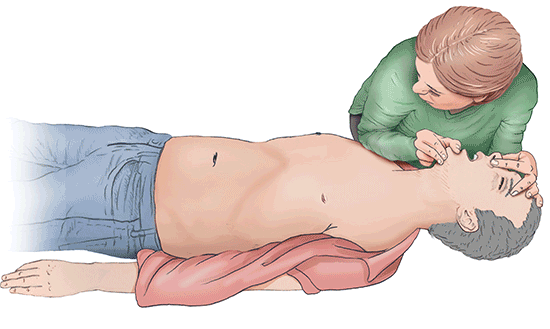Chest compressions are the most important part of resuscitating someone. Also helping them to breathe by providing mouth-to mouth resuscitation is helpful, but not absolutely necessary. But if you feel confident that you can do it, for instance following a first aid course, you should combine chest compressions with mouth-to-mouth resuscitation.
Mouth-to-mouth resuscitation follows a rhythm of 30 to 2: After doing 30 chest compressions, you give the unconscious person two rescue breaths, followed by 30 chest compressions, and so on. The important thing is that the rescue breaths are done quickly. The chest compressions should not be interrupted for more than ten seconds.
This is how to give mouth-to-mouth resuscitation:
- Hold the person's chin with your hand so that their mouth is open. Use your thumb to help keep their mouth open.
- Place your other hand on their forehead and pinch their nose between your index finger and thumb.
- Take a normal breath, cover and seal their open mouth with yours, and blow into their mouth for about one second. Their chest should rise visibly when you breathe into their mouth, and sink again as soon as you move away.
Olasveengen TM, Semeraro F, Ristagno G et al. Basismaßnahmen zur Wiederbelebung Erwachsener (Basic Life Support). Leitlinien des European Resuscitation Council 2021. Notf Rett Med 2021 [Epub ahead of print]: 1-20.
IQWiG health information is written with the aim of helping people understand the advantages and disadvantages of the main treatment options and health care services.
Because IQWiG is a German institute, some of the information provided here is specific to the German health care system. The suitability of any of the described options in an individual case can be determined by talking to a doctor. informedhealth.org can provide support for talks with doctors and other medical professionals, but cannot replace them. We do not offer individual consultations.
Our information is based on the results of good-quality studies. It is written by a team of health care professionals, scientists and editors, and reviewed by external experts. You can find a detailed description of how our health information is produced and updated in our methods.
Stay informed
Subscribe to our newsletter or newsfeed. You can find our growing collection of films on YouTube.

